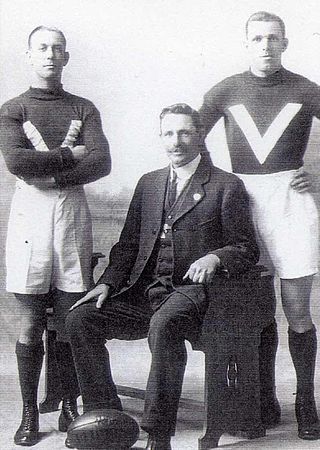
William Hixon McDonald (junior) (1840-1898) was an Australian miner, political candidate and pioneer of Corindhap, Victoria.

William Hixon McDonald (junior) (1840-1898) was an Australian miner, political candidate and pioneer of Corindhap, Victoria.
William McDonald was born in Green Ponds (now known as Kempton), Van Diemen's Land on 8 June 1840. His father, William Hixon McDonald (senior), was a soldier with the 2nd/51st King’s Own Light Infantry Regiment and had been stationed in Van Diemen's Land since 1838. [1]
After his father purchased a discharge from the army, the family crossed the Bass Strait to settle on the mainland at Freshwater Creek in the Parish of Duneed, south of Geelong in 1847. [2] It was here, that McDonald met and married Kezia Rankin (1844-1893), daughter of Samuel and Sarah Rankin and the aunt of Edwin ‘Teddy’ Rankin, the renowned Geelong footballer. [3] William and Kezia had 15 children. [4] Other members of the Rankin family also played for Geelong.
During the Victorian goldrush, the McDonalds moved to Corindhap, where both father and son tried their luck at the Break o'Day diggings. They were among the first and most successful miners of the region, unearthing, with other partners in 1877, one of the biggest nuggets of the district, dubbed the ‘Christmas Gift’ and weighing 175 ounces. [5]
McDonald used the money he earned on the Corindhap goldfields to purchase farming land. He also worked as a blacksmith, part-time. By 1868 he had accumulated over 200 acres and built a fine stone homestead. The family was burnt out in 1869, losing their home and possessions. McDonald rebuilt and went on to become a leading citizen of the fledgling Corindhap and Rokewood communities. [6] He managed the mining interests in the area for Elders Estate and served as auditor for a number of companies, including North Mack’s Lucky Gold Mining Company and Laidler’s Extended Company. In 1889, he was appointed mining registrar for the Staffordshire Reef district and led a successful campaign to create a school for the district. [7] He also captained the Rokewood cricket team. [8]
McDonald's wife Kezia died in 1893, when he was 52 and with four of his nine surviving children still living at home. The following year, he married 40-year-old widow Eliza Underwood. [9]
In 1897 McDonald stood in the local municipal elections, having been approached to stand as a candidate for West Riding of the Shire of Leigh, but he fell ill and was unable to mount an effective election campaign. He was defeated in the poll. [10] He died from a stroke on 23 April 1898 and is buried in Rokewood Cemetery near Corindhap. [11]
William Macdonald or MacDonald or McDonald may refer to:
Corindhap is a town in the Australian state of Victoria located on the Ballarat-Colac Road, 38.9 km from Ballarat and 62.9 km from Colac. Formerly known as Break O'Day.

Charles Swanston was a British merchant, banker, and politician, and a financial backer of the Port Phillip Association.
Francis McNeiss McNeil McCallum was a Scottish-born Australian notorious bushranger during the early part of the Victorian Gold Rush in Australia.
Charles Henry Pannam was an Australian rules footballer who played for the Collingwood Football Club in the Victorian Football Association (VFA) between 1894 and 1896 then in the Victorian Football League (VFL) between 1897 and 1906. He then played for the Richmond Football Club in the VFA in 1907 then in the VFL in 1908. He was senior coach of Richmond in 1907 and 1912.

Albert Vivian Rankin was an Australian rules footballer who played with Geelong in the Victorian Football League (VFL). His brothers Cliff and Doug as well as his father Teddy and other members of the family played league football for Geelong.

Edwin Walter "Teddy" Rankin was an Australian rules footballer, originally with Riversdale, who began playing with Geelong in the VFA in 1891, and later played in the Victorian Football League (VFL).

Herbert Howson was an Australian rules footballer who played with South Melbourne in the Victorian Football League (VFL).

William Henry Proudfoot was an Australian rules footballer who played for the Collingwood Football Club in the Victorian Football League (VFL) and Victorian Football Association (VFA).

William Joseph McSpeerin was an Australian rules footballer who played for the Fitzroy Football Club in the Victorian Football League (VFL).
Walter Charles Moore was an Australian rules footballer who played for Albert Park and South Melbourne in the Victorian Football Association (VFA) and for Essendon in the Victorian Football League (VFL). He served as a trooper in the Anglo-Boer War, but died of wounds after a battle.
Edwin Ernest 'Eddy' James was an Australian rules footballer who played for Geelong in the years before and following the formation of the VFL.
Bill 'Newhaven' Jackson was an Australian cyclist and an Australian rules footballer who played for Essendon and St Kilda in the Victorian Football League (VFL).
Edwin Douglas Rankin was an Australian rules footballer who played with Geelong in the Victorian Football League (VFL).
Frederick Charles Porter (1832–1869) was an Australian miner and explorer of the Gippsland region of Victoria. His exploration work in early 1862 was critical in helping open up the Jordan goldfields.
James Frederick Porter (1855-1919) was an Australian engineer and mine manager of the Gippsland region of Victoria.

William Hixon McDonald (senior) (1815-1869) was an Australian soldier-settler, who was amongst the first gold miners at Corindhap, Victoria.

The Rankins were a pioneering family of the Geelong district. The family produced a dynasty of champion Australian rules footballers, including three captains of the Geelong Football Club, two Carji Greeves medallists and played 582 games for Geelong, between them.

Thomas Charles Rankin was an Australian rules footballer who played with Geelong in the Victorian Football League (VFL). His brother, Edwin and other members of the Rankin family also played for Geelong.
William Hixon McDonald may refer to: